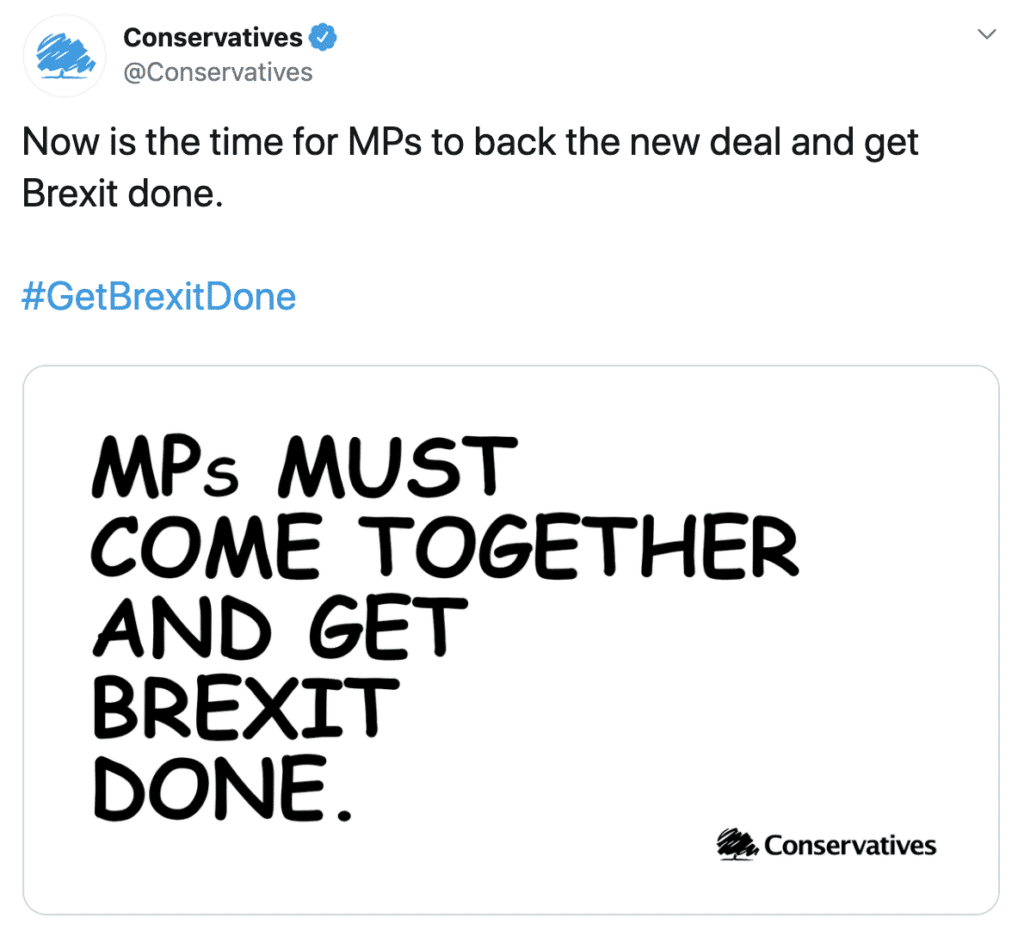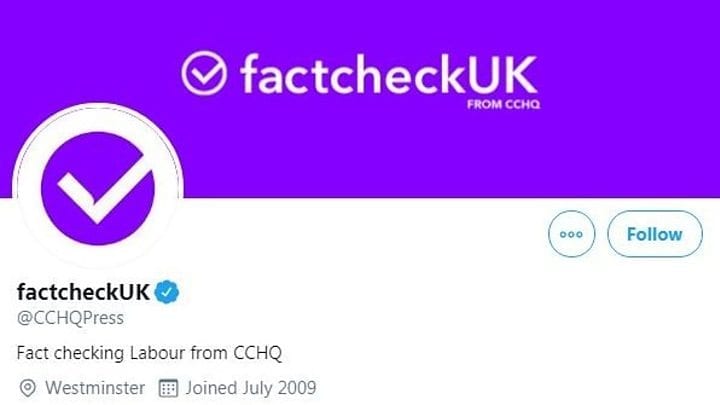Last Tuesday during the ITV pre-election debate between Boris Johnson and Jeremy Corbyn, the Conservative Party renamed the official @CCHQPress Twitter account to ‘factcheckUK’.
The party also temporarily replaced its profile picture with a tick logo and a header image with the logo, the text ‘factcheck UK’ and then in much smaller font ‘from CCHQ’, giving the account the appearance of being a verified fact-checking account.
In one of the tweets posted under the new moniker, the Conservative account posted a short video with the words ‘factcheckUK verdict’ declaring Johnson the winner of the debate.
Plenty of Twitter users called out the deception while it was happening, with others saying that the move was a ploy by the Conservatives to get people to organically share their content. Recent stunts of this nature include the @CCHQPress account sharing the Conservative mantra of ‘get Brexit done’ in Comic Sans font – a tweet which was then shared for being poorly designed and for being a deliberate marketing stunt in equal measure.

But whilst the Comic Sans stunt was arguably an effective PR strategy, it’s part of a more worrying trend of political weaponisation of social media. The @CCHQPress rebrand and the Conservative Party’s subsequent lack of remorse revealed the extent to which UK political parties are openly using social media to mislead the public. And in the wider context of the Cambridge Analytica scandal, it further illustrated the power that social media platforms have to derail democracy.
Professor Andrew Chadwick, Professor of Political Communication in the Department of Communication and Media at Loughborough University, said: “My research in my book The Hybrid Media System has shown that the period during and immediately after a televised debate is crucial for the parties.
“They and their activist support networks online seek to steer the debate to suit the narratives they want to see appear in the headlines.
“Since the UK’s first live televised prime ministerial debates in 2010, this social media driven process has fed into the mainstream media’s post-debate analysis, not least because journalists are themselves looking for the story about the debate and the social media discussions are part of that story.
“Mine and my colleagues’ research also shows that many voters engage in dual screening — they watch the debate live on TV and they simultaneously engage on social media. This is what makes this particular example so tricky for the issue of trust in politics.”
Not long after the switch on Tuesday, the @CCHQPress account changed back to its regular branding and name.
Throughout last week, non partisan UK broadcasters gave a lot of coverage to the stunt, asking prominent party figures such as Michael Gove and the Conservative chairman James Cleverly for comment.
Cleverly, told BBC Newsnight: “We were calling out the inaccuracies that were coming out during the debate.”
Whilst it is absolutely correct that the public should be aware of any inaccuracies or misleading statements made during pre-election debates, this service is already provided by independent fact checking organisations such as Full Fact.
The Conservatives already had a platform to address any inaccuracies made in statements by Corbyn during the debate itself. So why did they feel the need to change the look and name of their Twitter account to perform this ‘public’ service?
Because they wanted to a) be the main subject of conversation after the debate finished and thereby dominate all the headlines (ever head of the aphorism ‘all press is good press’?) and b) because there was a genuine chance some Twitter users would fall for the ‘factcheckUK’ facade.
Professor Chadwick added: “The Conservatives might say that the public could have spotted that this was the party account but that’s a little disingenuous.
“In the rapid flows of information that occur during and immediately after the debate it can often become difficult to make sense of who’s saying what. We’ve all experienced this.
“Consider the example of a person who doesn’t use Twitter very often or perhaps doesn’t follow politics very often on Twitter.
“The data on this are not freely available but I think it’s a fair hypothesis that such people are more likely to be misled in cases of impersonation such as this, than those who are highly interested in politics and who follow it online.”
The activity by @CCHQPress’s verified account last week was in direct violation of Twitter’s Verified Account FAQs, where the company notes that it explicitly prohibits “intentionally misleading people on Twitter by changing one’s display name or bio.”
Twitter doesn’t say that it will remove the verified status of such accounts, but it does reserve the right to do so.
Furthermore, the general Twitter rules and policies state specifically that users, “… may not impersonate individuals, groups, or organisations in a manner that is intended to or does mislead, confuse, or deceive others.”
Addressing the specific breach of its policies last week, Twitter said: “Twitter is committed to facilitating healthy debate throughout the UK general election.
“We have global rules in place that prohibit behaviour that can mislead people, including those with verified accounts.
“Any further attempts to mislead people by editing verified profile information — in a manner seen during the U.K. Election Debate — will result in decisive corrective action.”
So Twitter agrees that the action was misleading, but it didn’t do anything to hold the @CCHQPress accountable on this occasion. And regardless of your political standpoint, that’s worrying.
Professor Chadwick said: “Regarding Twitter’s response, it would have been better for British democracy if the company had gone further than they did in rebuking the Conservatives.
“Twitter has clear rules regarding the blue-tick verified status and the Conservatives were in breach of those rules.
For example, it could have issued a temporary, short term suspension of the Conservatives’ account, on the condition that the suspension would be lifted when the account went back to the CCHQ profile.”
Twitter’s failure to properly condemn the behaviour comes after the platform’s CEO, Jack Dorsey, announced last month that Twitter would be banning political advertising.
But until the social media giant is prepared to enforce strict penalties for accounts which breach its own verified user guidelines, it might as well just put out an advert that says ‘Twitter backs Boris’.
Words by Beth Kirkbride
